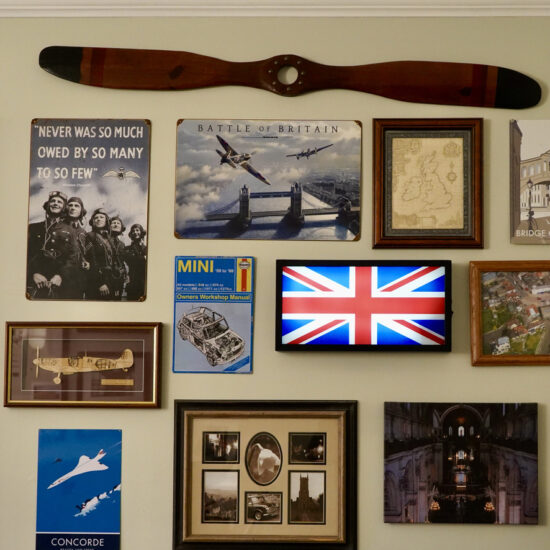From the Anglotopia Podcast: Episode 20
Welcome back to the Anglotopia Podcast! This is our second episode in the new series, and we’re overwhelmed by the kind words we received after our return. The comments on YouTube and Facebook were so encouraging—thank you for being such a wonderful community. We have exciting guests lined up for upcoming episodes, but today we’re diving into something close to our hearts: British children’s literature.
This week, we’re exploring the British stories and media that shaped us as children, influenced the creation of Anglotopia itself, and examining how things have changed with our own children’s generation. We’ll discuss our favorites, the timeless classics, and why British children’s literature has such a profound global impact.
As part of our podcast reboot, we’re bringing back the tea service tradition. Today we’re serving the house blend from Christ Church, Oxford—a custom tea from Twinings that’s served in the Great Hall for breakfast. It’s a flavorful blend that can only be purchased from the Christ Church gift shop, making it a special import and a perfect choice for today’s literary discussion.
The Velveteen Rabbit: A Story of Love and Transformation
Let’s start with a childhood favorite that resonates deeply: The Velveteen Rabbit by Margery Williams. This British story about a stuffed rabbit who becomes real through a child’s love is more than just a sweet tale—it’s a profound metaphor that grows with you.
The Story’s Power:
The premise is simple but moving: a child receives a velveteen rabbit as a gift. Through the child’s deep love, the rabbit eventually becomes real. The story involves the child getting scarlet fever (a common childhood illness in the era when it was written), and ultimately, the rabbit transforms into a living creature, bounding off into the garden.
As children, we absorbed this literally—the magic of loving something so much it comes alive. Many of us had our own special stuffed animals, carrying them everywhere, believing that if we loved them enough, they too might become real. It’s the kind of story that parents read to their children, reinforcing the idea that love has transformative power.
The Adult Interpretation:
Looking back as adults, The Velveteen Rabbit offers a different kind of wisdom. It becomes a metaphor for pursuing your goals and dreams: if you love something enough and pursue it with dedication, you can make it happen. You can’t literally make a stuffed animal come alive, but you can bring your dreams to life through commitment and passion.
This is exactly what happened with Anglotopia—a dream pursued with enough love and dedication that it became real, transforming from an idea into a thriving business and community.
A Generational Connection:
Interestingly, we both had velveteen rabbits as children, both loved the story, and later bought our daughter a rabbit at Harrods—a Jellycat brand bunny she named Brown Bunny. We even bought backups (every parent knows the panic of a lost beloved stuffed animal). Perhaps The Velveteen Rabbit influenced that choice more than we realized, passing the tradition to another generation.
Roald Dahl: The Master of Childhood Imagination
If there’s one British author who defined childhood for multiple generations, it’s Roald Dahl. His influence on children’s literature cannot be overstated, and his books were formative for both of us.
School Introduction:
Many American children encountered Roald Dahl through school. In third grade, Mrs. Barnum’s class introduced us to Charlie and the Chocolate Factory during story time. What kid doesn’t love a story about a magical chocolate factory? From there came James and the Giant Peach, Matilda, and others—exposure to deeply British stories that we didn’t fully recognize as British at the time.
When the Matilda movie came out, Hollywood had stripped much of the Britishness from it, making it feel like an American story. Only looking back do we fully appreciate how thoroughly British these tales are.
The Complete Collection:
When we got pregnant with our first child, we bought the complete Roald Dahl box set from Costco—all the books at once, ready for our children to discover. Ironically, they never read them. Not every childhood passion transfers automatically to the next generation, and that’s okay. There’s still time.
Why Dahl Endures:
Roald Dahl as a person has fallen somewhat out of fashion—he was notoriously difficult and held views that haven’t aged well. But his stories remain timeless because he built rich, imaginative worlds that speak directly to children’s experiences and fantasies.
What makes Dahl’s books so effective:
- Children are the heroes: In a world of grown-ups who often get things wrong, children triumph
- Horrible people exist: His books don’t shy away from showing bad adults and terrible situations
- Justice prevails: The bad guys always get their comeuppance in satisfying ways
- Childhood trauma is real: But children can overcome it
Who doesn’t remember loving the villains—Miss Trunchbull forcing Bruce Bogtrotter to eat an entire chocolate cake, only to have him succeed triumphantly? The witches, the Twits, the terrible aunts in James—these antagonists made the stories memorable because children love seeing heroes overcome truly horrible obstacles.
Beyond Fiction: Boy and Going Solo:
Two of Roald Dahl’s most influential works are his autobiographies: Boy: Tales of Childhood and Going Solo. These books had a profound impact on one of us as a child, shaping interests that would last a lifetime.
Boy chronicles Dahl’s childhood in the Welsh countryside, his Norwegian mother’s influence, and his time in Norway. Going Solo covers his adult years as an RAF pilot—thrilling stuff for an 11-year-old reading at the family lake cottage, unable to put the book down.
Looking back, these books planted seeds: a love of British airplanes, fascination with British military history, deep interest in World War II, and an appreciation for British storytelling. These weren’t just entertaining books—they were formative texts that shaped personality and lifelong interests.
The Global Reach of British Children’s Characters
As we prepared for this episode, we kept saying “Oh, and what about this one?” and “Don’t forget that!” It became clear just how much British literature and British-origin characters have been exported globally. These aren’t just beloved in the US—they’re recognized worldwide.
Paddington Bear
Paddington Bear, the marmalade-loving bear from Peru who lives with the Brown family in London, has become a global icon. Created by Michael Bond, Paddington first appeared in 1958 and has never left.
What makes Paddington special:
- His gentle nature and good intentions
- The humor that arises from misunderstandings
- His iconic blue coat and red hat
- His love of marmalade sandwiches
- The way he navigates being different in British society
The recent Paddington films have introduced a new generation to this beloved character, proving that good stories transcend time. Paddington represents kindness, tolerance, and the idea that outsiders can become treasured parts of the community—themes that resonate across cultures.
Winnie the Pooh
A.A. Milne’s creation of Winnie the Pooh and the Hundred Acre Wood gave the world one of literature’s most enduring characters. Though Disney has largely taken over the franchise, the original books remain classics of British children’s literature.
The stories of Pooh, Piglet, Eeyore, Tigger, and Christopher Robin are deceptively simple but contain profound observations about friendship, worry, joy, and the nature of childhood. The characters represent different personality types and ways of being in the world, giving children (and adults) figures to identify with.
Peter Rabbit
Beatrix Potter’s The Tale of Peter Rabbit and her subsequent books about various animals created a distinctly British rural world that has captivated readers since 1902. Peter’s adventures in Mr. McGregor’s garden, the stories of Jemima Puddle-Duck, Tom Kitten, and others combine beautiful illustrations with gentle stories about consequences, nature, and animal behavior.
The Lake District settings, the watercolor illustrations, and the precisely observed details of British countryside life give these books a timeless quality. They’re quintessentially British but universally understood.
Thomas the Tank Engine
The Reverend W. Awdry’s The Railway Series, featuring Thomas and his engine friends on the Island of Sodor, became a global phenomenon through television adaptation. Thomas the Tank Engine teaches lessons about responsibility, friendship, and doing your job well—all delivered through anthropomorphized trains.
For children fascinated by trains (and what young child isn’t?), Thomas provides endless entertainment while subtly introducing British culture, work ethic, and social dynamics. The series has evolved over decades, introducing new characters and adapting to modern sensibilities while maintaining its British roots.
The Modern Era: Harry Potter’s Global Domination
No discussion of British children’s literature is complete without J.K. Rowling’s Harry Potter series. These books represent the most successful children’s book series in history and have had an immeasurable impact on multiple generations.
A Cultural Phenomenon:
Harry Potter isn’t just a book series—it’s a cultural touchstone that defined childhood for millions born between the 1980s and early 2000s. The books grew with their readers, starting with the relatively simple Philosopher’s Stone and progressing to the much darker, more complex later volumes.
Why It Worked:
- A magical world with detailed rules: Rowling created a complete magical society with its own history, government, and logic
- Growing with readers: As Harry aged, so did the audience, and the themes matured accordingly
- Relatable hero: Harry was special but also ordinary, orphaned and uncertain, making him accessible
- British setting: Hogwarts, Diagon Alley, the Ministry of Magic—all distinctly British locations that introduced readers worldwide to British culture
- Universal themes: Friendship, courage, love, loss, good versus evil—themes that transcend culture
The Impact:
Harry Potter did something remarkable: it got a generation of children who were growing up with screens and video games to read enormous books. Kids waited in lines at midnight for book releases. They debated theories, wrote fan fiction, and created a fandom culture that continues today.
The books also introduced countless international readers to British culture, institutions, and ways of thinking. For many, Harry Potter was their first deep engagement with British literature and culture—a gateway to further exploration.
Television and Modern Media: The Next Generation
While we grew up reading books, our children’s generation has been shaped by television and streaming media as much as by print. British children’s shows have been just as influential as books, perhaps more so in recent years.
Peppa Pig: The Unlikely Global Star
Peppa Pig seems simple—a cartoon pig and her family having everyday adventures. But this British creation has become one of the most successful children’s franchises globally, particularly influential with very young children.
Why Peppa Works:
- Simple but effective animation: Clean, colorful, easy for young eyes to follow
- Relatable situations: Going to the dentist, visiting grandparents, playing in muddy puddles
- British culture subtly introduced: The show is thoroughly British in accent, setting, and sensibility
- Short episodes: Perfect for young attention spans
The American Accent Phenomenon:
Perhaps most surprisingly, Peppa Pig created what parents call “the Peppa effect”—young American children began speaking with British accents after watching the show. They’d call their mothers “Mummy,” pronounce schedule as “shed-yule,” and use British vocabulary. It’s a testament to how deeply children absorb media and how influential these shows are on language development.
Other British Children’s Shows
British television has exported numerous successful children’s programs:
- Bluey: While technically Australian, it follows in the British Commonwealth tradition of quality children’s programming
- Shaun the Sheep: Aardman’s wordless adventures of a clever sheep and his flock
- Fireman Sam: Welsh firefighter adventures teaching safety and community values
- Ben and Holly’s Little Kingdom: From the creators of Peppa Pig, teaching about friendship and problem-solving
These shows share common elements: they don’t talk down to children, they feature gentle humor adults can enjoy too, and they embed values and social skills within entertaining stories.
The Influence We Didn’t Recognize
Looking back, it’s remarkable how much British culture was naturally part of our childhoods without us fully recognizing it. There was no conspiracy to promote British literature—these were simply the stories that got published in America, became popular, and resonated with generation after generation.
This cultural exchange has shaped interests and passions in ways we only recognize in retrospect. The love of British history, the fascination with British culture, the eventual creation of Anglotopia—all of it traces back to those formative childhood exposures to British stories.
The Baseline and Beyond:
As Anglophiles raising children, we started with a baseline of British culture from our own childhoods, then actively added more through recommendations from British friends and Anglotopia readers. “You’ve got to get this book” became a common refrain, introducing our children to stories we’d missed or new classics that emerged after our own childhoods.
But we also embraced great American children’s literature—Dr. Seuss was bread and butter for both our childhoods and our children’s. This isn’t about British literature being superior; it’s about recognizing how thoroughly integrated British stories are into American childhood.
Why British Children’s Literature Endures
What makes British children’s literature so enduring and globally successful?
Quality Storytelling:
British authors have a tradition of taking children seriously as readers. They don’t shy away from complexity, darkness, or difficult themes. Bad things happen in British children’s books, but children triumph. This honest approach resonates with young readers who know life isn’t always easy.
Rich World-Building:
From Narnia to Hogwarts to the Hundred Acre Wood, British children’s literature excels at creating complete, believable worlds with their own internal logic. Children can immerse themselves in these worlds, returning again and again.
Memorable Characters:
British children’s literature gives us unforgettable characters—heroes we want to be and villains we love to hate. These characters feel real, with flaws and struggles alongside their strengths.
Timeless Themes:
The best British children’s literature deals with universal themes: friendship, courage, justice, belonging, love, loss. These themes transcend culture and time, making the stories relevant across generations.
The Sanitization Question:
There’s an ongoing debate about whether children’s literature should be sanitized to remove frightening or unpleasant elements. British children’s literature tends to resist this impulse. Roald Dahl’s Miss Trunchbull is genuinely frightening. Harry Potter deals with death, prejudice, and authoritarianism. These aren’t comfortable topics, but children engage with them eagerly.
Kids love the horrible elements in Roald Dahl books. The villains are what make the stories memorable. Children understand that there are bad adults in the world, and they find satisfaction in seeing justice done. British children’s literature trusts children to handle complex emotions and situations, and children rise to meet that trust.
What’s Next? The Future of British Children’s Literature
What will be the next Harry Potter? The next Peppa Pig? What will capture the zeitgeist and define childhood for the next generation?
The Fantasy Boom:
Young adult fantasy literature is experiencing explosive growth—not just with young adults but with actual adults too. There’s a clear desire for fantasy worlds, magical systems, and epic adventures. Somewhere in that realm, the next defining British series might emerge.
The Medium Shifts:
While books remain important, children’s media is increasingly multimedia. Stories begin as books but expand into television, films, apps, and interactive experiences. The next great British children’s property might start anywhere and expand everywhere.
What We Might Miss:
As we discussed these childhood favorites, we kept realizing how much we were inevitably leaving out. British children’s literature is vast—there are countless authors, series, and characters we didn’t touch on. Every family has their own favorites, their own formative texts.
Join the Conversation
We want to hear from you:
- What were your favorite British childhood stories?
- What resonates with you even as an adult?
- What has resonated with your own children?
- What’s your guilty pleasure that you still watch or read as a grown-up?
- What massive gaps did we leave in this discussion?
These conversations are always about what we left out as much as what we included. With only an hour for a podcast, we can barely scratch the surface of this rich topic.
The Bottom Line
British children’s literature has shaped generations of readers around the world. From The Velveteen Rabbit to Harry Potter, from Paddington Bear to Peppa Pig, these stories have traveled far beyond Britain’s shores to become part of global childhood.
They’ve influenced how we think, what we value, and even the careers we’ve chosen. They’ve given us comfort in difficult times, sparked our imaginations, taught us about courage and friendship, and opened windows into a culture many of us would later come to love deeply.
As adults, we return to these stories with new appreciation. We see the craft behind them, understand the themes more deeply, and recognize how they shaped us. And we have the joy of introducing new generations to these timeless tales, watching children discover the same magic we once found.
British children’s literature isn’t going anywhere. The classics endure because they’re genuinely good stories well told. New classics emerge regularly. And children around the world continue to fall in love with British stories, just as we did decades ago.
What are your favorite British children’s books or shows? Share your memories and recommendations in the comments. And if you haven’t already, check out the previous episode where we discussed the return of the Anglotopia Podcast and our plans for the season ahead.
Subscribe to the Anglotopia Podcast for more discussions about British culture, travel, history, and all things Anglophile. Coming up, we have exciting guest interviews that you won’t want to miss!
Free Podcast Newsletter
Subscribe to our special podcast newsletter below and never miss the latest episode of the Anglotopia Podcast.




